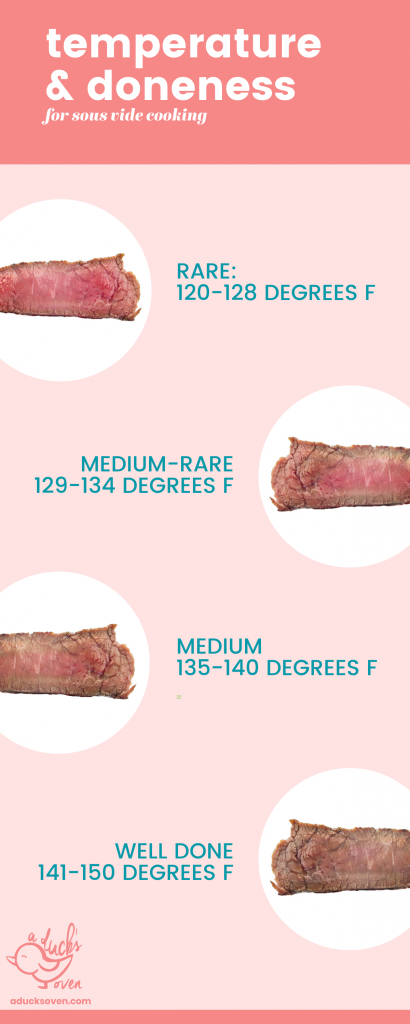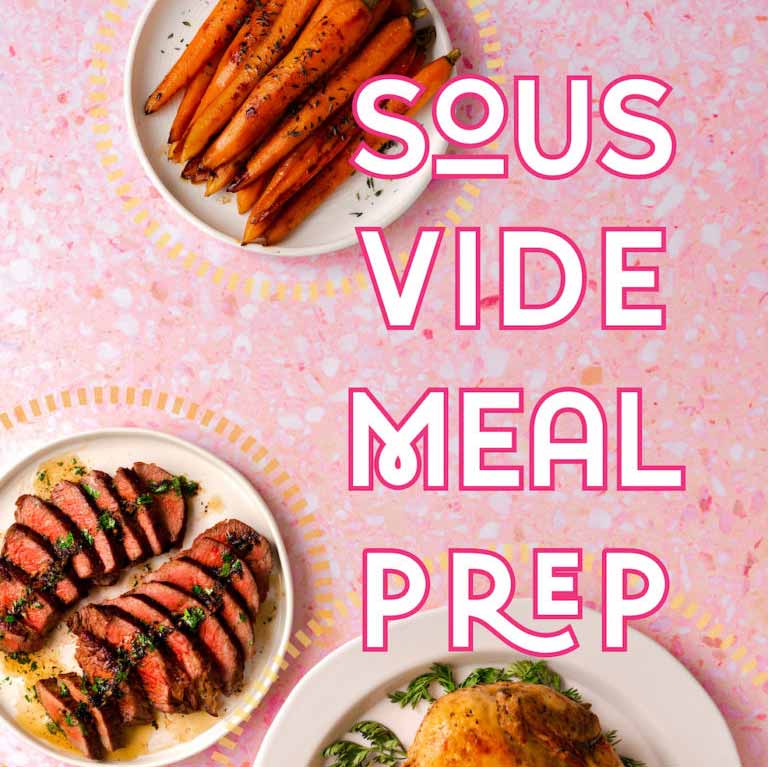What is Sous Vide? A Beginner’s Guide.
Sous vide is a cooking method that’s also referred to as “precision cooking”. While it’s mostly known for Starbucks’ Sous Vide Egg Bites and perfectly cooked steak, the cooking method is perfect for so many applications!
Sous vide can seem intimidating at first, but once you understand the science behind it, it actually makes cooking so much easier. Anything that’s hard to cook can typically be made easier thanks to sous vide.
Why should you learn from me? I’ve been food blogging since 2010 and using sous vide since 2016. I have dozens of sous vide recipes for you to use here on this website. You can find more recipes in my cookbooks, Everyday Sous Vide and Sous Vide Meal Prep. I also teach beginning home cooks everything they need to know about sous vide cooking in my digital guide, Sous Vide School. I believe sous vide has the power to make home cooks’ lives easier. Sure, I do a few fun sous vide projects (like sous vide brisket!) but mostly, we stick to the basics around here.
Sous Vide School
My beginner’s interactive guide to sous vide cooking will teach you how to make sous vide dinners, desserts, drinks and more while saving time and money!
Table of Contents
- How to Pronounce Sous Vide
- What is Sous Vide Cooking?
- How Does Sous Vide Work?
- Can You Overcook Meat?
- Sous Vide Cooking and Safety
- Is Sous Vide Worth It?
- Sous Vide Equipment for Beginners
- Recipes to Get Started
- Sous Vide Education
How to Pronounce Sous Vide
It’s totally okay if you’re not sure how to pronounce this very French cooking term! Okay, here’s how you pronounce it in English. Ready?
Soo (like “moo”) veed. Go forth and sound like a pro.
What is Sous Vide Cooking?
Let’s get the dictionary definitions out of the way: sous vide is a French method of cooking and translates to “under vacuum”. People have experimented with different elements of the sous vide cooking process for centuries (low and slow cooking, cooking under pressure, etc.) but it was only all put together in the 1970s in France.
Okay, now: what is sous vide cooking? Sous vide is a cooking method in which you put your food in a food safe bag and remove the air or a jar then place it in a water bath that holds at a specific temperature for an extended period of time. So, a consistent cooking heat, usually for slightly longer than you’d “normally” cook your food. Got it? Food in bag/jar, bag/jar in water bath, leave it there for a while.
To sous vide, all you have to do is fill a container (this can simply be a stockpot) with water and place an immersion circulator in the water. Like you would set the temperature on a hot tub, you do the same on the immersion circulator.
An immersion circulator is what makes a sous vide bath like a hot tub instead of a little pool. It heats and circulates the water.
Once you press “Start”, the immersion circulator will move the water through the heat coils inside the machine, then back into the water bath. It will bring all of the water up to and then keep it at your desired precise temperature.
How Does Sous Vide Work?
Let’s use sous vide steak as our example food. The doneness of steak is related to the temperature the center of the steak reaches. This means the center of a rare steak is literally colder than the center of a well-done steak.
What is doneness? You know when you’re at a restaurant and the server asks, “How do you want this cooked?” and you say “Medium-rare, please”? That’s doneness.

Using sous vide, you can keep a water bath at the exact temperature you’d like. I like a medium-rare steak, so I cook it at 129 degrees F. When I place a vacuum-sealed steak in a water bath set to this temp, it never has the opportunity to cook any hotter than 129 degrees F because the entire cooking environment is 129 degrees F.
Let’s say you wanted to cook the steak in your oven and you set your oven to 425 degrees F. You have to pull your steak out at that magical, unknown moment the center reaches 129 degrees F, or you’ll overcook it. That’s a big ask!
In a sous vide water bath, I could cook that steak for days, and it would still be rare, because it’s all about temperature. You’re reading this correctly: you’ll never ruin a good cut of meat again. You can’t overcook it, no matter how long you cook it.

Can You Overcook Meat?
The short answer: You can’t overcook your meat in terms of “doneness” when sous viding, but you can over tenderize it.
Not only is it nearly impossible to overcook, you’ll also have that perfect medium-rare texture from edge to edge instead of rings of varying doneness to just a medium rare center.
See the photo below: the steak on the left was cooked sous vide and quickly seared in a very hot cast iron skillet. The steak on the right was pan seared from start to finish.

However, the longer you cook the meat, the more you change the texture. Time exposed to heat = tissue breakdown. Which can sometimes be desirable! For example, if you get a tougher cut from the butcher or you’re looking to get a pork shoulder pull apart tender, you can accomplish that with more time and you won’t risk drying it out the way you do with a crockpot.
Sous Vide Cooking and Safety
Sous vide cooking can be even safer than traditional cooking methods when done correctly. The main thing to make sure it’s done correctly: check on your circulator every now and then to make sure it’s still running! Sometimes they fail. They are just electronics, after all.
Pasteurization
For our squeamish people, you can pasteurize a medium steak, killing all the germs but still keeping that lovely texture. No more well-done steaks for our germaphobes (I’m looking at you, father-in-law)! This is done by cooking food at 130 degrees F or higher, and making sure the food stays at that temperature for at least several minutes.
A common question that comes up: Why can I cook at temperatures lower than 165 degrees F when cooking sous vide chicken? We all know 165 to be the magic chicken number!
The information provided by experts like the USDA around food safety often sacrifices detail in favor of being easy to understand. Which I get! But 165 degrees F isn’t the full story.
Temperature guidelines are there to make sure you kill bacteria, the big one being salmonella when we’re cooking chicken. We want to pasteurize the chicken. Pasteurization is related to both time AND temperature.
The reason 165 degrees F is the gold standard is because chicken is instantly pasteurized at that temperature. The lowest temperature I offer for cooking chicken is 140 degrees F. If your chicken is 140 degrees F all the way through for at least 27.5 minutes, it will be pasteurized! And I recommend a minimum of 2 hours to allow for plenty of time for it to get to temperature and be there for far longer than 27.5 minutes.
At 145 degrees F you only need 9.2 minutes, at 150 degrees F you only need 2.8 minutes, and at 155 degrees F you only need 47.7 seconds! Pretty neat, huh?
To learn more about this, I recommend this article from Serious Eats.
Sous Vide Bags
People get freaked out about cooking in a bag. I get it! But I’m here to tell you it’s perfectly safe. Don’t overthink it.
Look for food safe, BPA free bags and the terms “high-density polyethylene,” “low-density polyethylene,” and “polypropylene.” Almost all vacuum seal bags are perfectly safe for cooking below boiling (212 degrees F). If you’re using zipper top bags, get high quality and make sure they’re freezer grade.
Avoid polycarbonate plastic, which is used for cling wrap, plastic squeeze bottles, take-out containers, multi-gallon water bottles, and plastic plates.
To learn more about safety and sous vide, I recommend this Cook’s Illustrated article.
Is Sous Vide Worth It?
Obviously I’ve been converted, so it’s a resounding YES from me! Sous vide is worth it because it takes all the guesswork out of cooking for you. No babysitting, worrying about over or under cooking, or struggling to cook expensive foods like fish and steak well. It’s going to be perfect every single time.
My one caveat: I’m not sure it would be worth investing in the setup if you’re vegetarian/vegan. While you can cook veggies, grains, egg bites, desserts, and more incredibly with sous vide, you may not be using it often enough for it to feel “worth it.” If kitchen space and money aren’t an issue, go for it.
Sous Vide Equipment for Beginners
All you really need to get started with sous vide cooking is an immersion circulator. My favorite circulator is the Breville Joule. Costco has a great bundle that includes an Anova circulator and a water bath container.
However, there are lots of other “nice to haves”. You can get my up to date, linked list here:
Recipes to Get Started
Okay, ready to get started with sous vide cooking? The recipes below are listed in an order I think would be best for beginners to take. Let’s go!
- Sous Vide Tri Tip Steak
- High Protein, Low Fat Sous Vide Egg Bites
- Sous Vide Pork Chops (Bone In or Boneless)
- Sous Vide Chicken Breasts
- Sous Vide Salmon
- Cilantro Lime Sous Vide Shrimp
- Sous Vide Chicken Thighs
- Sous Vide Smoked Beef Brisket
And there are plenty more sous vide recipes on this website to keep you going.
Sous Vide Education
Looking to learn even more about sous vide cooking? I’ve created several resources that were designed to support home cooks in the kitchen and help them learn how sous vide could make everyday cooking so much easier.
Sous Vide School
Sous vide school is my beginner’s interactive guide to sous vide cooking. This collection of videos, text, resources, and “labs” will help you feel confident when it comes to sous vide!
Sous Vide Meal Prep
This cookbook outlines my entire method for keeping your freezer stocked with ready to sous vide meals (and some great recipes to boot!).



You are my go-to person for all things sous vide! Thank you so much for all the valuable information, I love the infographics!!
Awww Becca!! Thank you!!!